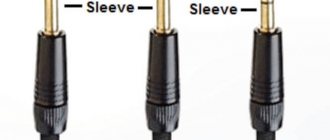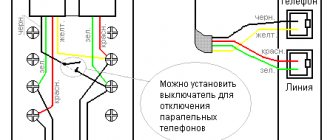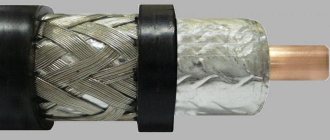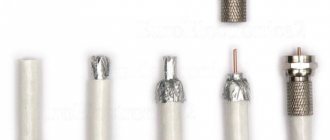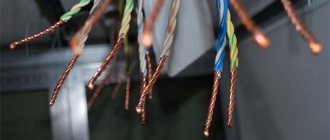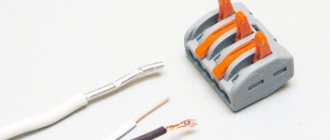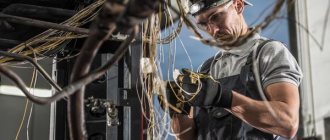The installation of power supply systems must ensure their safety and reliability. And the main vector of attention must be directed to the connection points of the wires. An amateur approach to the matter saves minor money, but does not provide the required level of quality and security of the system. Only knowledge of the technical conditions and features of specific components makes it possible to provide the connections with the proper quality, and the user - confidence in the safety and durability of the electrical system of the room. Putting the technical point at the forefront, we will see that the most reliable and safe method of connecting electrical wiring is welding!
To carry out welding work you will need a welding machine and some skill. An overview of the devices is given below, and to acquire the skill you just need to read the article and practice a little.
Existing methods of connecting conductors
Basic methods of connecting conductors in a house or apartment
Connecting wires can be done in several ways:
- welding is the most reliable method, ensuring high reliability of the connection, but requiring skills and the presence of a welding machine;
- terminal blocks - a simple and fairly reliable connection;
- soldering - works well if the currents do not exceed the norm and the connection does not heat up to temperatures above the norm (65°C);
- crimping with sleeves - requires knowledge of technology, special pliers, but the connection is reliable;
- use of spring clamps - wago, PPE - are quickly installed and, subject to operating conditions, ensure good contact;
- bolted connection - easy to perform, usually used in difficult cases - when it is necessary to switch from aluminum to copper and vice versa.
The specific type of connection is selected based on many factors. It is necessary to take into account the material of the conductor, its cross-section, the number of cores, the type of insulation, the number of conductors that will be connected, as well as operating conditions. Based on these factors, we will consider each type of connection.
In what cases is a connection needed?
Inverters for welding are equipped with short wires, which creates difficulties when performing work at heights and in hard-to-reach places. Connecting welding cables using soldering, welding or installing special connectors expands the capabilities of the equipment and eliminates the need to hold it on the shoulder. When carrying out this task, it must be taken into account that the maximum length should not exceed 30-40 m.
Welding – high reliability in any conditions
When connecting wires by welding, the conductors are twisted and their ends are welded. As a result, a metal ball is formed, which provides a stable and very reliable connection in any conditions. Moreover, it is reliable not only in terms of electrical characteristics, but also mechanically - the metal of the connected wires after melting forms a monolith and it is impossible to isolate a separate conductor.
Welding - it is important to heat the metal, but not melt the insulation
The disadvantage of this type of wire connection is that the connection is 100% permanent. If you need to change something, you need to cut off the fused piece and do it all over again. Therefore, for such connections, a certain supply of wires is left in case of possible alterations.
Other disadvantages include the need for a welding machine, appropriate electrodes, flux and operating skills. In addition, welding takes a lot of time, it is necessary to protect surrounding objects, and it is also inconvenient to work with a welder at height. Therefore, electricians practice this type of connection in exceptional cases. If you are doing it “for yourself” and know how to handle a welding machine well, you can practice on scraps. The main trick is to not melt the insulation, but to weld the metal.
After cooling, the welding site is isolated. You can use electrical tape, you can use heat shrink tubing.
Welding aluminum wires
Aluminum wires have been used in construction for a long time and in the overwhelming majority. The soft pliability of aluminum tempts you to connect wires using the twisting method. As a result, the largest number of accidents and fires occur due to the unacceptably low quality of such connections. The oxide film formed on the surface of an aluminum wire has high resistance, which leads to overheating of the wires at the contact points. According to the Electrical Installation Rules (PUE), connecting aluminum wires in this way is prohibited. There are several acceptable methods, but all of them are inferior in reliability and safety to the welding method.
The main difficulties when welding aluminum are the rapid formation of an oxide film and the relatively low melting point. The use of fluxes prevents oxidation during operation, and the use of a welding machine in reduced power mode does not lead to wire fluidity due to overheating.
Before welding, you need to strip the wires of 50 - 70 mm of insulation and 20 -30 mm of oxide film and twist them. The end plane must be smooth and clean. Twisting is carried out before the actual welding. Point contact during work falls on it. This applies to all types of wires.
Flux must be added to the recess of the electrode. Then, with a quick movement, avoiding overheating, weld the wires along the end with a sliding touch. The touch time should not exceed 2 - 3 seconds. If you don't have this experience, practice for a while. The main point is the confidence of tangential movement to the end with an instant shift along the plane. The uniformity of the formed drop of alloy will serve as an assessment of your practice.
After cooling, the connection must be insulated.
Connecting wires by crimping
To crimp wires, a special aluminum or copper sleeve is required - it is selected based on the size of the twist (bundle diameter), and the material is the same as for the conductors. The bare wires, stripped to a shine, are twisted, a tube-sleeve is put on them, which is clamped with special pliers.
An example of crimping conductors with a sleeve
Both sleeves and pliers are different, there are several types. Each of them has its own rules of use (the number of wires that can be packed in a sleeve), which you need to be well versed in. It is necessary to pack the wires according to certain rules, measure the size of the resulting bundle, and adjust it to the requirements. In general, a rather dreary task. Therefore, this type of wire connection is mainly used by professional electricians, and more and more often they are switching to spring clamps.
Terminal blocks
One of the simplest and most reliable wire connections is through terminal blocks. There are several types, but almost all of them use a screw connection. There are sockets of different sizes - for different sizes of conductors, with different numbers of pairs - from 2 to 20 or more.
The terminal block itself is a plastic case in which a metal socket or plate is sealed. A bare conductor is inserted into this socket or between the plates and clamped with a screw. After the screw is tightened, you need to give the conductor a good tug to make sure it is tightly clamped. Due to the fact that the connection points remain uninsulated, the terminal blocks are used in rooms with normal humidity.
The disadvantage of such a connection: due to the ductility of metals - especially aluminum - the contact weakens over time, which can lead to an increase in the degree of heating and accelerated oxidation, which again leads to a decrease in contact. In general, the connection of wires in screw terminal boxes must be tightened periodically.
Connecting wires in terminal blocks
Advantages - speed, simplicity, low cost, does not require any skills, except the ability to use a screwdriver. Another important advantage is that you can easily connect wires of different diameters, single-core and stranded, copper and aluminum. There is no direct contact, so there are no risks.
Soldering
First, about soldering technology. The connected conductors are stripped of insulation, cleared of the oxide film to bare metal, twisted, and then tinned. To do this, the conductors are heated with a soldering iron and applied to rosin. It should cover the joint completely. Tinned wires are twisted first with your fingers, then pressed using pliers. Instead of tinning, you can use soldering flux. They wet the wires well, but after twisting.
Then, in fact, the soldering process begins: the joint is heated with a soldering iron or narrow torch. When rosin or flux begins to boil, take some of the solder onto the soldering iron tip and bring it into the soldering zone, pressing the tip against the conductors. The solder flows to fill the gaps between the wires, making a good connection. When using a torch, solder is simply added little by little into the torch.
Next, after the soldering area has cooled, according to the technology, it is necessary to wash off the remaining flux (they accelerate oxidation), dry the joint, cover it with a special protective varnish, and then insulate it with electrical tape and/or heat-shrinkable tubes.
Now about the advantages and disadvantages of this method of connecting wires. In low-current systems, soldering is one of the most reliable methods of connecting wires. But, when installing electrical wiring in a house or apartment, it is criticized mercilessly. The thing is that solder has a low melting point. When large currents periodically pass through the connection (this happens if the circuit breakers are incorrectly selected or faulty), the solder gradually melts and evaporates. Over and over again, the contact becomes worse and the connection heats up more and more. If this process is not detected, the matter may well end in a fire.
The second negative point is the low mechanical strength of soldering. It's the tin again - it's soft. If there are a lot of wires in a soldered joint, and if they are also rigid, when you try to pack them, the conductors often fall out of the solder joint - the elastic force is too great, which pulls them out. That is why it is not recommended to use soldering connections when wiring electricity: it is inconvenient, time-consuming and risky.
Connecting the welding cable with connectors
The simplest and most effective method of connecting welding conductors is the method using connectors. To do it correctly, you need to choose wisely:
- welding cable brands,
- connectors,
- tips,
- plugs and terminals.
The choice of cable connector depends on the conductor cross-section. The latter can be determined using a micrometer or caliper. The connector can have an area of 10, 25, 35...120 mm2. There are two designs of devices - pin (“male”) and female (“female”). To connect them to the equipment, you need special sockets that act as a response component of the plug.
When purchasing lugs, you need to pay attention to the standard size (must correspond to the cross-sectional area of the wire) and materials of manufacture. Preference should be given to products with chrome plating, which prevents oxidation.
The crimp connection is extremely simple. It consists of stripping products of insulation, combining cores into bundles, putting on connectors and clamping them.
Spring clamps for connecting wires
One of the most controversial ways to connect wires is using spring clamps. There are several types, but the two most common are wago terminal blocks and PPE caps. Externally and in terms of installation method, they are very different, but both designs are based on a spring, which creates strong contact with the wire.
There is controversy about this spring. Opponents of using wago say that the spring will weaken over time, the contact will become worse, the connection will begin to heat up more and more, which, again, leads to an even more rapid decrease in the degree of elasticity of the spring. After some time, the temperature may rise so much that the body (plastic) will melt, but what can happen next is known.
Spring clamps for electrical wiring - popular connections for wires
In defense of using spring clamps to connect wires, if they are used according to manufacturers' recommendations, problems are very, very rare. Although there are many fakes of both wago and PPE, as well as a sufficient number of photographs of them in melted form. But, at the same time, many people use them, and, under normal operating conditions, they work for years without complaints.
wago wire clamps
They appeared on our market several years ago and made a lot of noise: with their help, the connection is very quick and easy, and at the same time has high reliability. The manufacturer has specific recommendations for using this product:
- wago should only be used for single-core or stranded conductors with a cross-section from 0.5 mm2 to 4 mm2;
- to fix and connect stranded and small-diameter wires, use the CAGE CLAMP - from 0.08 mm2 to 35 mm2;
What's inside wago wire clamps
Inside these devices there is a metal plate, which ensures the proper degree of contact. The shape and its parameters of the plates were specially developed and tested. The tests were carried out on a vibration stand for many hours, then heated and cooled. After which the electrical parameters of the connection were checked. All tests were passed “excellent” and branded products always perform “five”.
In general, the range of Wago products is very wide, but for installing electrical wiring or connecting home appliances and lighting fixtures, two types of wire clamps are used: series 222 (detachable) with the ability to reconnect or change the connection, and series 773 and 273 - which are called permanent.
Detachable
Spring clamps for electrical wiring Wago 222 series have a certain number of contact pads - from two to five - and the same number of locking flags. Before starting the connection, the flags are raised up, the conductors stripped of insulation are inserted into them (all the way), after which the flag is lowered. At this point the connection is considered complete.
Wago wire connectors - connection methods
If necessary, you can reconnect the connection - lift the locking flag and remove the conductor. Convenient, fast and reliable.
Wago 222 series range
The 222 Vago series can be used to connect two or three, even five conductors made of copper or aluminum (you can connect different metals in one terminal). Wires can be single-core or multi-core, but with rigid wires. The maximum cross-section is 2.5 mm2. Soft stranded wires can be connected with a cross-section from 0.08 mm2 to 4 mm2.
One-piece
There is another type of clamps that does not provide the ability to redo the connection of wires - series 773 and 273. When using these terminals, the work is generally done in seconds: the stripped wire is inserted into the appropriate socket. The spring present there clamps it, ensuring contact with the plate. All.
wago contact terminals
These spring loaded wire clamps can be used to connect solid aluminum or copper wires with cross-sectional area from 0.75 mm2 to 2.5 mm2, stranded wires with rigid wires from 1.5 mm2 to 2.5 mm2. Soft stranded conductors cannot be connected using such connectors.
Types of mounting terminals for wago wiring
To improve contact, the wires must be cleaned of oxide film before connecting. To prevent oxidation from continuing, wago manufacturers also produce contact paste. The inside of the clamp is filled with it and it itself corrodes the oxide film, and then protects the wires from oxidation in the future. In this case, only heavily oxidized, dark conductors need preliminary stripping, and the clamp body is filled with paste.
By the way, manufacturers say that, if desired, the wire can be pulled out of the clamp. To do this, grab the wire with one hand, hold the terminal box with the other and rotate them back and forth with a small range, in opposite directions, stretching them in different directions.
Clamps for lamps (construction and installation terminals for lamps)
For quick and convenient connection of lamps or sconces, wago has special 224 series terminals. With their help, you can connect aluminum or copper wires of different sections and types (single-core or stranded with rigid wires). The rated voltage of this connection is 400 V, rated current:
- for copper conductors - 24 A
- 16 A for aluminum.
Methods for connecting wires in chandeliers and sconces using wago clamps
Cross-section of connected conductors from the mounting side:
- copper 1.0 ÷ 2.5 mm2 – single-core;
- aluminum 2.5 mm2 – single-core.
Cross-section of connected conductors on the side of the chandelier/sconce: copper 0.5 ÷ 2.5 mm2 – single-core, stranded, tinned, crimped.
When connecting aluminum wires, it is necessary to use contact paste, and copper wires must be stripped by hand to bare metal.
This product has two disadvantages. The first is that the price of original terminals is high. Secondly, there are a lot of fakes at a lower price, but their quality is much lower and they burn and melt. Therefore, despite the high cost, it is better to buy original products.
PPE caps
PPE caps (which stands for “connector insulating clips”) are very easy to use devices. This is a plastic case, inside of which there is a spring that has a conical shape. The conductors, stripped of insulation, are inserted into the cap, and the cap is turned clockwise several times. You will feel that it has stopped scrolling, which means the connection is ready.
How to make a wire connection using PPE
These conductor connectors are produced by many manufacturers; they are available in different sizes, for different diameters and the number of connected conductors. In order for the wire connection to be reliable, the size must be selected correctly, and for this you need to understand the markings.
After the letters PPE there are several numbers. Depending on the manufacturer, the number of numbers varies, but they mean the same things. For example, there is this type of marking: SIZ-1 1.5-3.5 or SIZ-2 4.5-12. In this case, the number immediately following the letters indicates the type of case. “1” is set if the body is a regular cone, on the surface of which grooves can be applied for better grip. If there is a SIZ-2, then there are small protrusions on the body that are convenient to grasp with your fingers and twist.
All other numbers reflect the total cross-section of all conductors that can be connected using this particular PPE cap.
An example of marking of PPE caps and its explanation
For example, PPE-1 2.0-4.0. This means that the body of the connecting cap is ordinary, cone-shaped. With its help, you can connect two conductors with a cross section of at least 0.5 mm2 (in total they give 1 mm, which meets the minimum requirements - see the table). This cap contains a maximum of conductors whose total cross-section should not exceed 4 mm2.
Connecting wires using PPE caps
In the second version of marking, after the abbreviation PPE there is only a number from 1 to 5. In this case, you just need to remember which of them is useful for which cross-section of wires. The data is in another table.
PPE caps and their parameters
By the way, only copper wires can be connected with PPE caps - aluminum wires, as a rule, are thicker than the maximum allowable for these connectors.
Tip Installation: Process Principles
Since it is correct to connect a welding cable using lugs, this procedure is most often performed to lengthen and create a convenient shape for the end of the conductive core necessary for connection to the clamp of the device.
To do this, you need to strip and treat the wire with paste, place the tip on the end of the cable and press it until it stops. After this, the product should be crimped using tongs or a matrix press. To increase the mobility of the welding machine, you can extend the wire using different connection technologies. Our specialists recommend using connectors selected according to the cross-section and composition of the core bundle, observing the sequence and rules of the method used. To purchase electrical components, you need to go to the catalog. If difficulties arise with the choice, our manager will provide professional advice.
Bolted connection
This connection is assembled from a bolt of any diameter, a suitable nut and one, or better yet, three washers. It is assembled quickly and easily, serves quite a long time and reliably.
Bolted wire connection
First, the conductors are stripped of insulation and, if necessary, the top oxidized layer is removed. Next, a loop is formed from the stripped part, the internal diameter of which is equal to the diameter of the bolt. To make it easier, you can wrap the wire around the bolt and tighten it (middle option in the right picture). Afterwards it all comes together in this order:
- A washer is placed on the bolt.
- One of the conductors.
- Second puck.
- Another conductor.
- Third puck.
- Screw.
The connection is tightened first with your hands, then with the help of keys (you can take pliers). That's all, the connection is ready. It is used mainly if it is necessary to make a connection between wires made of copper and aluminum; it can also be used when connecting conductors of different diameters.
How to connect aluminum and copper conductors
By the way, let us remind you why you cannot directly connect copper and aluminum wires. There are two reasons:
- This connection gets very hot, which in itself is very bad.
- Over time, the contact weakens. This happens because aluminum has a lower electrical conductivity than copper, and as a result, when the same currents pass through, it heats up more. When heated, it expands more, squeezing out the copper conductor - the connection becomes worse and gets hotter.
To avoid such troubles, copper and aluminum conductors are connected using:
- terminal blocks;
- wago;
- bolted connection;
- branch clamps (make connections of wires on the street).
Other types of connectors cannot be used.
